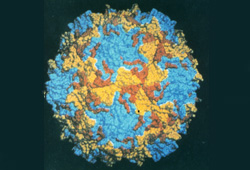Resumo
Definição
História e exame físico
Principais fatores diagnósticos
- estado não imunizado
- residência ou viagem a área endêmica
- diminuição do tônus e da função motora do membro afetado
- diminuição dos reflexos tendinosos do membro afetado
- atrofia muscular do membro afetado
Outros fatores diagnósticos
- idade <36 meses
- pródromo gastrointestinal
- febre
- mal-estar
- atrofia dos músculos respiratórios e dificuldade respiratória
Fatores de risco
- falta de vacinação
- saneamento precário
- pobreza
- área com infecção endêmica
- imunossupressão
Investigações diagnósticas
Investigações a serem consideradas
- culturas virais de fezes, líquido cefalorraquidiano (LCR) ou faringe
- Reação em cadeia da polimerase e sequenciamento
- análise do líquido cefalorraquidiano (LCR)
- anticorpos séricos para poliovírus
- ressonância nuclear magnética (RNM) da medula espinhal
- eletromiografia (EMG) do membro afetado
Algoritmo de tratamento
Colaboradores
Autores
Omar A. Khan, MD, MHS, FAAFP

President and CEO
Delaware Health Sciences Alliance
Physician Leader, Partnerships & Academic Programs
Christiana Care Health System
Associate Professor
Department of Family & Community Medicine
Sidney Kimmel Medical College of Thomas Jefferson University
Newark
DE
Declarações
OAK is an author of a number of references cited in this topic.
David L. Heymann, MD, DTM&H
Professor of Infectious Disease Epidemiology
London School of Hygiene and Tropical Medicine
University of London
Head
Centre on Global Health Security - Chatham House
London
UK
Declarações
DLH is an author of a number of references cited in this topic.
Revisores
Javed M. Gilani, MD, FRCP, FACP
Assistant Clinical Professor
Jefferson Medical College
Philadelphia
PA
Declarações
JMG declares that he has no competing interests.
Gregory Pappas, MD, PhD
The Nordin M. Thobani Professor and Chairman
Department of Community Health Sciences
Aga Khan University
Karachi
Pakistan
Declarações
GP declares that he has no competing interests.
Créditos aos pareceristas
Os tópicos do BMJ Best Practice são constantemente atualizados, seguindo os desenvolvimentos das evidências e das diretrizes. Os pareceristas aqui listados revisaram o conteúdo pelo menos uma vez durante a história do tópico.
Declarações
As afiliações e declarações dos pareceristas referem--se ao momento da revisão.
Referências
Principais artigos
Heymann DL, Aylward RB. Eradicating polio. N Engl J Med. 2004 Sep 23;351(13):1275-7. Resumo
Global Polio Eradication Initiative. GPEI Strategy 2022-2026. 2021 [internet publication].Texto completo
Farbu E, Gilhus NE, Barnes MP, et al. Post-polio syndrome: EFNS guidelines on post-polio syndrome. In: Gilhus NE, Barnes MP, Brainin M, eds. European Handbook of Neurological Management, Volume 1. 2nd ed. West Sussex, UK: Blackwell Publishing Ltd.; 2011:311-9.
Artigos de referência
Uma lista completa das fontes referenciadas neste tópico está disponível aqui.
O uso deste conteúdo está sujeito ao nosso aviso legal

